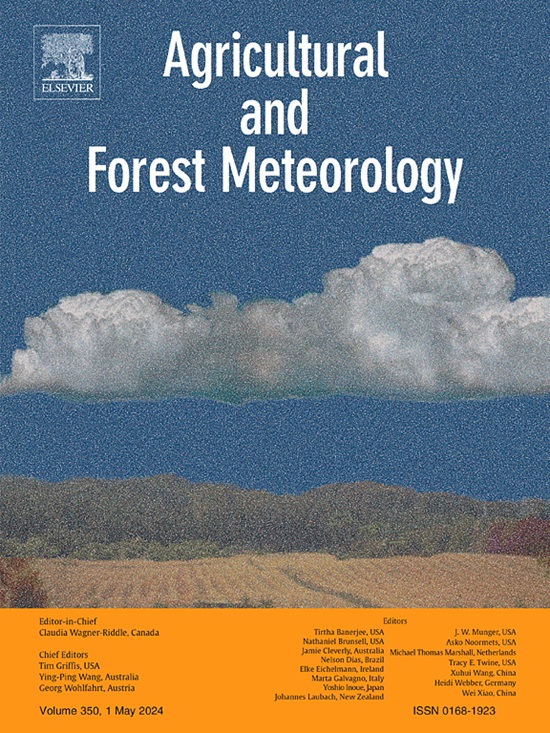观测到陆地总初级生产力的光利用效率不断提高
IF 5.6
1区 农林科学
Q1 AGRONOMY
引用次数: 0
摘要
二氧化碳施肥驱动的全球大面积绿化意味着树冠结构更加密集,更多的树叶可用于从大气中收集光进行植物光合作用。叶片数量的增加是否能提高植被将吸收的光转化为光合产物的能力仍不清楚。在这项研究中,我们利用 FLUXNET 记录的 540 个站点年的数据和七个卫星衍生代用指标,研究了冠层光利用效率(LUE)的时空变化,这是叶片光合作用能力的一个指标。我们发现,通量塔的测量结果表明 LUE 呈上升趋势,而跨站点 LUE 的时间变化主要由氮肥(18.09%)、温度(17.06%)和二氧化碳施肥(16.59%)引起。在全球范围内,卫星数据集也显示,在过去二十年中,LUE普遍增加,这主要归因于氮沉降和二氧化碳施肥效应,尤其是在常绿阔叶林中。CMIP6 地球系统模型对陆地 LUE 的未来预测进一步表明,到 21 世纪末,LUE 总体呈上升趋势。我们的研究结果凸显了植被生理学(如 LUE)在理解气候变化对陆地植物光合作用和碳汇的影响方面的重要性。本文章由计算机程序翻译,如有差异,请以英文原文为准。
Observed increasing light-use efficiency of terrestrial gross primary productivity
Widespread global greening driven by CO2 fertilization implies a denser canopy structure, and more leaves could be used to collect light from the atmosphere for plant photosynthesis. Whether this increase in leaf quantity could enhance the capacity of vegetation to convert absorbed light to photosynthate remains unclear. In this study, we investigate the spatial-temporal variations of canopy light-use efficiency (LUE), an indicator of leaf photosynthesis capacity, with FLUXNET recordings of 540 site-years and seven satellite-derived proxies. We find that flux tower measurements identify an increasing trend of LUE, and the temporal variations of cross-site LUE are mainly caused by nitrogen fertilization (18.09 %), temperature (17.06 %), and CO2 fertilization (16.59 %). Globally, satellite-derived datasets also show widespread increasing LUE over the past two decades, most attributed to the nitrogen deposition and CO2 fertilization effects, especially in evergreen broadleaf forests. Future projections of terrestrial LUE by CMIP6 Earth system models further suggest an overall increasing trend of LUE to the end of the 21st century. Our findings highlight the importance of vegetation physiology such as LUE in understanding of enhancement on terrestrial plant photosynthesis and carbon sink under climate change.
求助全文
通过发布文献求助,成功后即可免费获取论文全文。
去求助
来源期刊
CiteScore
10.30
自引率
9.70%
发文量
415
审稿时长
69 days
期刊介绍:
Agricultural and Forest Meteorology is an international journal for the publication of original articles and reviews on the inter-relationship between meteorology, agriculture, forestry, and natural ecosystems. Emphasis is on basic and applied scientific research relevant to practical problems in the field of plant and soil sciences, ecology and biogeochemistry as affected by weather as well as climate variability and change. Theoretical models should be tested against experimental data. Articles must appeal to an international audience. Special issues devoted to single topics are also published.
Typical topics include canopy micrometeorology (e.g. canopy radiation transfer, turbulence near the ground, evapotranspiration, energy balance, fluxes of trace gases), micrometeorological instrumentation (e.g., sensors for trace gases, flux measurement instruments, radiation measurement techniques), aerobiology (e.g. the dispersion of pollen, spores, insects and pesticides), biometeorology (e.g. the effect of weather and climate on plant distribution, crop yield, water-use efficiency, and plant phenology), forest-fire/weather interactions, and feedbacks from vegetation to weather and the climate system.

 求助内容:
求助内容: 应助结果提醒方式:
应助结果提醒方式:


